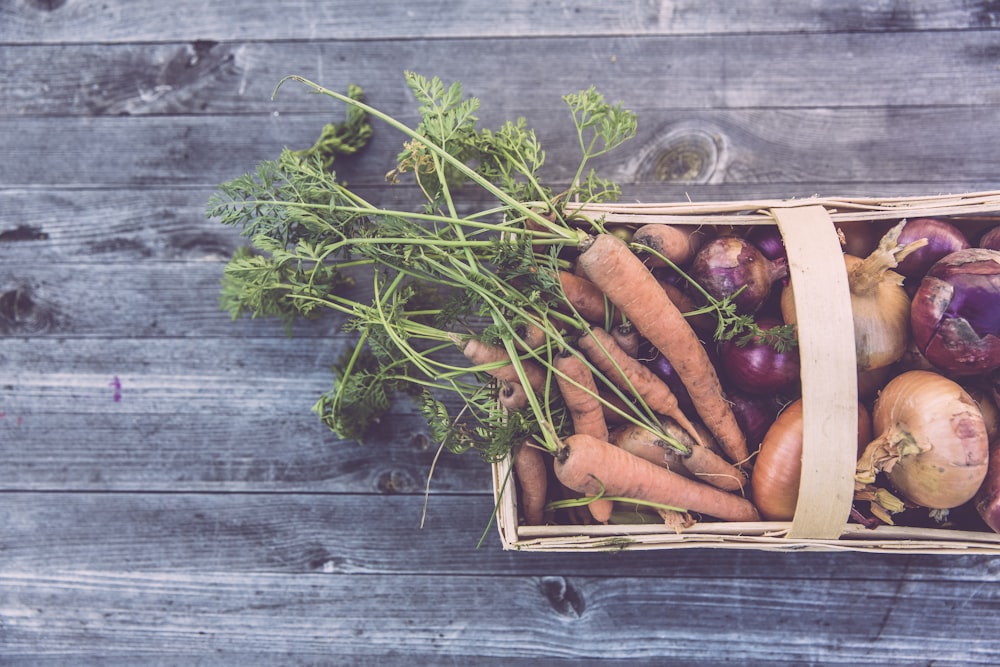How to Create a Self-Sustaining Garden to Feed You and Your Family
Have you always wanted to live off the land & get the most of your meals from a personal garden, but never knew how to get started? Learn today with our guide!
Guide: How to Create a Self-Sustaining Garden to Feed You and Your Family
Basket of carrots and onions on wood table (basket-carrots-onions-wood-table)Photo by Markus Spiske on Unsplash
A lot of us have entertained the fantasy that we should ditch the grocery store and the fast food chains entirely, and simply live off the land like our forefathers and foremothers used to do. And the good news is that it doesn’t have to be a simple fantasy: plenty of people do it every day! But that doesn’t mean you won’t need the facts, a lot of hard work and a little bit of luck to help you succeed. Learn how to grow a sustainable garden for you and your family to enjoy every day.
Getting the Tools You Need
You’re never going to get the garden of your dreams if you don’t start crafting it the right way. And you don’t necessarily have to rely on a big chain to get the planting supplies you need, either: lots of regional stores have a robust inventory comparable to the warehouse franchises, and also give back to their local communities in more significant ways. Do some research on the best local farm and AG providers in your area, and you can do justice to the concept of locality and sustainability before your garden even sets down its first root!
Location, Location, Location
Next, you’ll want to think about the perfect place to set your garden. According to the Washington Post, some of the biggest considerations you’ll have to think about when you’re choosing a spot include the amount of sunlight you’ll get, the quality of your soil, and the elevation of your land, among other things. And if your own land doesn’t have many of these qualities in spades, don’t worry: there are many spaces that will allow you to plant a garden there for a small, or even no, fee.
Choosing the Right Produce
A good domestic garden gives you great opportunities for making great meals using every element of your produce, but that doesn’t necessarily mean you’ll be able to grow whatever you wish wherever you want. Unless you have access to a climate-controlled greenhouse, you’ll have to do some research on what kinds of vegetables and fruits will grow best in your region’s climate, and even on your own soil’s elevation and moisture quality. Check out what the farmers around you are growing on their own lands and see how you can learn from what they’re doing.
Hands holding small bushel of small tomatoes (hands-holding-tomatoes)Photo by Jametlene Reskp on Unsplash
Maintaining and Caring For Your Garden
Prepping your tools, finding the right land and choosing the right produce is only the beginning of your journey. Now comes the hard work of caring for your garden through rain and shine, no matter what the weather or the climate may try to do to your plants. You’ll have to make sure the ground is watered consistently and that the soil is mulched regularly, and you’ll have to set up tents and coverings for when the weather turns for the worse. It’s important to remember that gardens are full of living things, and if you think of taking care of your garden in much the same way you’d feed and exercise your pets, it’ll be easier to do the hard work when the going gets tough.
Rotating Your Produce
With the world’s climate in such a precarious place, it stands to reason that a lot of the rules of farming are changing, and not every season is going to be the best for every kind of produce in the ways they used to be. You’ll have to research what kinds of fruits and vegetables will function best in your ground, and at what times, and be willing to rotate them out when the situation calls for something different. This might seem like a hassle at first, but it actually means that you can invest in a variety of seeds and growing materials and make sure that your garden does the work of feeding you all year round. Remember that you’re in this for the long haul, and a little bit of inconvenience in changing plants is nothing compared to the nutrition you’re getting from your crops and the money you’re saving by avoiding the grocery store.
Seeing the Big Picture
All of these tips play into one big idea, which is that by creating your own sustainable garden you’re doing your part to make the world a better and healthier place for us all. With the future as uncertain as ever, and with no sign that that will change anytime soon, we need everyone to do their part. Taking the tips you’ve read here and using them to make your own sustainable food source can play a small role in making the big picture that much brighter.
Did we miss any vital tips on ways to make your own sustainable garden? Do you have any success stories of your own for making organic food sources in your own backyard? Leave us a comment down below and let your voice be heard!










Follow Us!